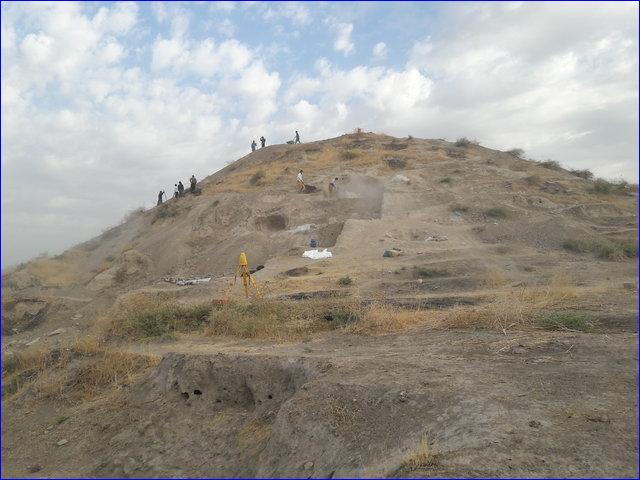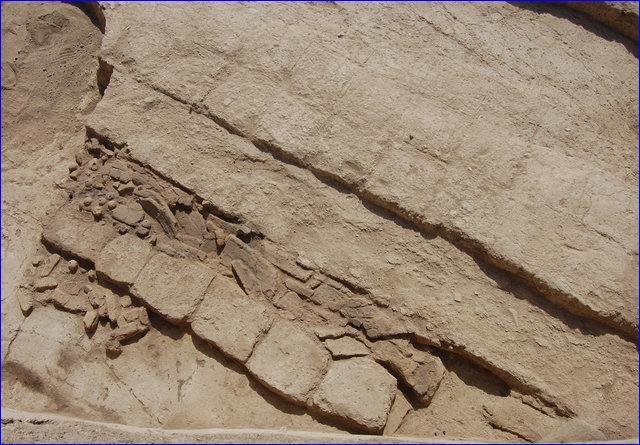


 Jutta Eichholz)
Jutta Eichholz)
Iraq and nearby Iran's history are therefore of great interest to archaeologists, who often must face both manmade and natural challenges when working in the region. Earthquakes, such as the 7.3 magnitude on that struck Iran and Iraq on November 12, threaten not only people, but also invaluable archaeological artifacts that are important to the collective history of humankind.
A recent six-week excavation in the province fortuitously ended before the earthquake struck. The work focused on the 7.4-acre site Gird-î Qalrakh on the Shahrizor Plain, and unearthed evidence for an ancient, centuries-old textile industry in a region now famed for its colorful Iraqi-Kurdish carpets and related woven goods.
The discoveries almost didn't happen.
Project leader Dirk Wicke of the Institute of Archaeology at Goethe University and his team were wrapping up their excavation, when student Lanah Haddad noticed a wall from a mysterious room within the trench where she was digging. Wicke asked her to keep removing dirt. As she did, several clay weights became visible, along with the charred remains of a large ancient loom.
"Lanah worked hard with the support of 1--2 students, and I decided to leave her trench alone and open for 2 more days -- which was really worth it," Wicke told Seeker.

 Dirk Wicke)
Dirk Wicke)
His curiosity grew over other clay objects in the trench, due to their slightly off color and texture. Similar moments have happened to him before, he said, explaining that when he sees such clues, he will try to turn the clay objects over, in order to identify possible lines, dots, and curves, which form a pattern or shape.
"Once carefully dry-cleaned in the dig house, you start to twist the find beneath strong light from all sides in order to identify the images," he said. "In this case, they were beautiful Sasanian griffins and horses."
Griffins -- mythical creatures with the head and wings of an eagle and the body of a lion -- are perhaps best known to people today from the popular Harry Potter films.
Although the lighting was poor in the tiny, cramped dig house where he and his team were based during the excavation, they were able to photograph the griffin. His team determined that the object and others found with it were probably seals from rolls of fabric.
About 16 and a half feet below the layer where the loom and seals were discovered, the researchers found an elaborate cylinder seal dating to a much earlier time, the 9th-7th century BC Assyrian period. Assyria refers to a major Mesopotamian kingdom that, at its peak, stretched from Cyprus and the East Mediterranean to Iran, and from what is now Armenia and Azerbaijan in the Caucasus, to the Arabian Peninsula, Egypt, and eastern Libya.
The scientists were able to take a clear photo of the Assyrian cylinder seal.
"The seal was used as in modern administrative procedures -- to function like a signature and authorize a treaty, letter, or other official document," Wicke said. "One has to bear in mind, that the Assyrian documents were written in cuneiform script on wet, clay tablets, which later dried or got baked to last."
The cylinder seal depicts two winged genies with a purifying "cone" and a bucket of purifying liquid that was most likely water. The genies, he said, "flank a sacred tree expressing purification," which is "a standard topic in neo-Assyrian art."
"It is difficult to pinpoint an exact meaning to it, but this image was very often depicted in the royal palaces and appears to act as a beneficiary motif used to magically protect the king and inhabitants of the palace or palaces," he said.
On the back of this seal, opposite the tree, is a spade associated with the Babylonian god Marduk. This suggests that the seal was made and used when there were strong connections between Assyria and Babylonia, which was another ancient empire at the time.
Also dating to the 9th-7th century BC is a terraced, stone wall. The archaeologists believe it was part of a watchtower.
Wicke said that the land at the site was, and still is, "very fertile," making it an attractive location for settlement. Additionally, springs upstream of the site provide a near-continuous supply of fresh water, even during the hot and arid summer months.
It is little wonder then that people thrived on the Shahrizor plain during the much later era of the loom, which to an untrained eye looks a bit like a skeleton stretched out in a grave. The pieces instead are what is left of the large standing device that featured vertical hanging threads, which were pulled vertically straight by the clay loom weights. The threads were then woven horizontally.
"This is one of the oldest arrangements of a loom," Wicke said.

 Lanah Haddad)
Lanah Haddad)
Wicke suspected that for many centuries prior to around 4 AD it was home to a small farming community, but now they are rethinking its significance.
"It looks as if the site was taking part in a larger, overarching network of the textile trade, but this, of course, needs further examination," he said. "Why it was burnt, I really can't say."
The loom and seals came as a surprise to the researchers, who are studying the region's ceramic history that currently "still lacks a coherent pattern chronology," Wicke said. This work has been funded since 2015 by the local antiquities cervice, the Thyssen Foundation, and the Enki e.V. Association located at Goethe.
By focusing on a particular mound at the site, his team's goal concerning the ceramic research is to unearth and classify pottery for each time period, revealing how uses, designs, crafting techniques evolved. For example, Wicke is curious when, and if, the locals began importing ceramics, and what the pottery might reveal about the local cuisine and early dining habits.
The fact that the researchers were able to study the site at all represents a research breakthrough. During former Iraqi president Saddam Hussein's fight against the Kurds, Wicke said "a ramp for tanks and armed vehicles with probably heavy guns was constructed along one side of the mound, damaging it."
Earthquakes and other natural disasters notwithstanding, Wicke said: "I felt completely safe working in Iraqi-Kurdistan. The local colleagues were all very helpful and welcoming."
He admitted that the budget for the project was tight. As a result, his team shared accommodations in a small house "with little privacy," so the generosity of the locals was all the more appreciated. Depending on further funding and political and natural developments in the Iraqi-Kurdish region, he hopes to continue the excavation work next year.

or register to post a comment.